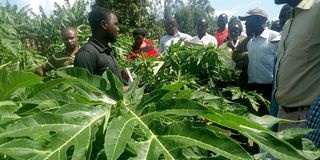Ask the Experts

TIPS FOR GROWING PAWPAWS
My pawpaws are bitter, what should I do to sweeten them?
Jadiel
Generally, ripe pawpaws are supposed to be sweet with butter-like consistency.
However, raw pawpaws together with their seeds contain papain (an enzyme used to digest proteins), which makes them bitter.
Bitterness in pawpaws occurs when during fruit development, the pawpaw plant underwent some stress as a result of nutrient deficiency, pests and diseases such as mosaic or ring spot, inadequate water and unfavourable temperature.
Therefore, for successful fruit production, guard against the above. On the other hand, sweetness of pawpaws tends to reduce in low temperature areas – you did not specify where you are growing them.
Nitrogen application is important in the fruit yield, but application of a high rate also increases the level of papain.
Key nutrients
Apart from nitrogen, phosphorus and potassium are also essential for better performance of pawpaws. Fertiliser application should be done six months to the time of fruit harvesting.
Pawpaws also have different cultivars, therefore, grafting high disease and pest resistant rootstock with a scion of high fruit yielding with sweeter fruit qualities can also solve your problem.
The Red Lady F1 variety has the ability to yield up to 54-120 fruits when the trees reach peak production in two years.
Considering that an acre farm can hold up to 1,000 trees, a farmer is likely to harvest close to 54,000 fruits in a season and a whopping 108,000 fruits in a year for the three seasons.
Production advantage
A Red Lady FI Pawpaw has a reddish orange flesh and weighs 400-650g. This variety produces flowers which have both male and female parts and are capable of self- pollination. Other features include high resistance to ring spot virus, a long production span of up to 10 years very sweet fruits with uniform size and shape. Unlike most pawpaw varieties that produce twice in a year, Red Lady FI variety produces thrice per year
Growing condition
Just like other varieties, Red Lady variety grows well in well drained soils with a PH value of 5.5 to 7.0.
It require warm to hot climates for growth, and an altitude below 2100m above sea level, with well annual rainfall of about 1000mm which is well distributed.
Planting
A farmer can decide to make his own seedbed or sow Red Lady FI seeds directly in a farm at the rate of four seeds per hole before reducing them to one per hole when they reach 10-15 cm in height.
The spacing of 2.5m in between rows and 2m from a tree to another is recommended.

REARING GOATS
I wish to rear goats for meat on an acre. What would be an appropriate breed and where can I acquire them?
John
Raising goats for commercial meat production is a great business idea with good returns on investment as consumer tastes change.
This, should, thus enable you adopt a suitable production plan with appropriate feeding, breeding, disease control and flock size that sustainably fits within your production resources for profit.
Galla and Boer goats both do well for meat production and with time, you cross them with the Small East African goats which are the most common.
Always when selecting the foundation stock, never start with animals from a sale yard that have been culled by other farmers.
I am farming watermelons, which are one-month-old now. Is there a substance that is applied to these plants to make the fruits sweet or the sweetness in the melons is just natural?
Wahome

HOW TO SWEETEN WATERMELON
The sweetness of the watermelon is also influenced greatly by the climate. Hot weather tends to contribute to the sweetness of the crop because watermelon is a warm season crop and also requires plenty of sunlight.
For sweetening, you need foliar application of micronutrients, especially boron, once the fruit has set.
Two weeks before the fruit is ripe, stop watering because the less water it gets the better as this will increase the sugar content and sugar concentration in the fruit, making it sweeter.
When you start picking the watermelons, only pick the ripe ones because they don’t continue to ripen after picking.
Answered by Carol Mutua




